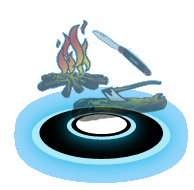So you're out camping and you find large pieces of wood that you could use for your campfire.
However, you find out that they are just a bit too big for you to use.
What do you do?
Well, you could always bring out the axe (also spelled as ax) to help you out.
With an axe, you could easily break down large pieces of wood that you may find difficult to do with a small knife.
While there are many different types of axes available for use, the most common type of axe a scout may use is the hatchet (also known as a hand-axe).
Typically, the axe will have a metal top with a wooden handle.
With it's small size the hatchet can be used with one hand to cut and trim wood.
|
Materials
Back in the days one of the common materials used to make axes was stone.
Nowadays, axes are mostly made with steel heads and wooden handles.
Axe handles can also be made of other materials, such as plastic or fiberglass.
|
 
 
|
Parts of an Axe
Just like the knife, the axe is also composed of different parts.
However, while the knife may have multiple components, the axe only has 2 primary ones: the head and the haft.
|
Head
The head of an axe basically identifies the metal component that is used for chopping wood.
Within the head, additional parts include the sharp bit (or blade) at the front and the butt at the back.
The butt has a flat end and can be used similarly like a hammer.
|
Haft
The haft of an axe may also be known as the handle.
There are 5 named parts of the handle and they can be identified with the human parts of the body.
The neck of the handle is located just below the head while the shoulder is the back portion of the neck.
Also on the haft is the grip, where the user would normally hold the handle.
At the bottom of the haft, there lies the toe and the heel.
The toe is the inside portion of the bottom and while the heel is the lowest portion of the handle.
|
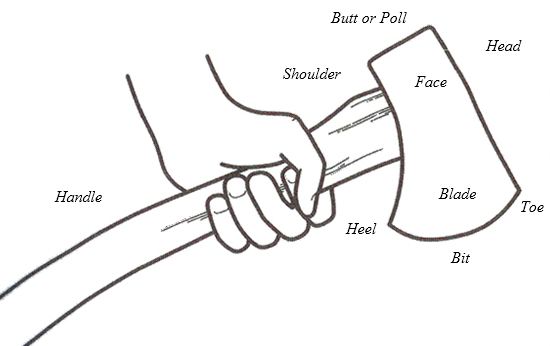
|
Care and Maintenance
Like with all tools that you use, it's always important to keep them maintained so it could be ready when you need it; an axe is no different.
If you want to keep it sharp you must take the time to sharpen it.
Below are some tips to keep in mind as you care for your axe.
- When the axe is not in use, put the mask or sheath on so you can protect the bit and prevent injury to others. The chopping block can be used as a temporary mask, but make sure the blade follows the grain of the wood, is secured in the wood, and that the haft would not be in anyone's way.
- Keep the axe dry to prevent rusting. Don't leave them out in the open overnight.
- Grease the axe head and oil the wooden handle.
- If the haft is damaged, replace it with a new one. It can be dangerous using an axe with a damaged haft (accidents do happen!)
- Keep your axe sharp. It's way better and much safer than using a blunt one.
|
Sharpening the Axe
To sharpen your axe, you will need a mill bastard file, a small log and a couple of stakes or reebars.
For safety purposes, you should wear gloves and safety glasses.
The sharpening process is as follows:
- Hammer the stakes or reebars into the ground and brace the axe head between them and the log. Make sure the axe is secured and will not shift during this the sharpening process.
- Place the file on the edge of the blade and push it into the bit as you slide it over. Be sure to lift the file up as you finish the stroke before starting again.
- To sharpen the other side, turn the axe around and repeat the process.
|
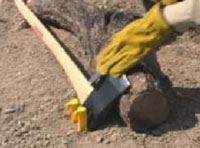
|
Safety
As always, when handling sharp objects, safety is key to preventing “accidents.”
When the axe is not in use, don't forget to cover the bit with the sheath.
The mask will protect the sharp blade from being damaged as well as people from getting hurt.
|
Handling and Carrying
Whenever you handle the axe, it is always best to keep the bit from facing your body.
That way if you do happen to trip and fall, you won't fall on your axe.
Using the sheath to cover the bit is always recommended, especially when the axe is not in use.
The best way to carry the axe is to hold the area where the head meets the shoulder.
Ensure that the blade is facing away from your body.
|
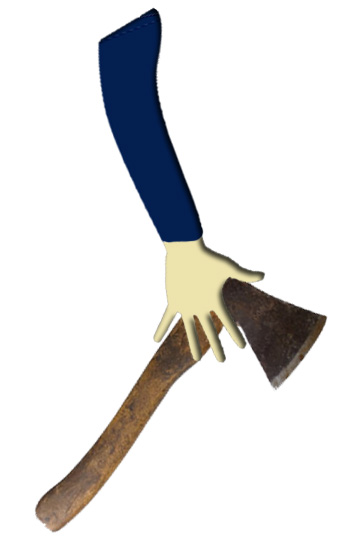
|
When it comes to the time where you have to pass the axe to another person, there are two ways to do so.
The first way is to hold the handle with the head down and the bit facing away from you or the person you're passing to.
When the person receives the axe and has a firm grip on the handle, an acknowledgment of “Thank You” should be given as a signal to release your hold.
The second way is to chop the axe into the chopping block.
When it is safely secured, leave the axe yard and let the next person enter.
|
Axe Yard
The axe yard is a designated area where the axe is to be used.
This location should be free of brush in all direction.
To determine whether the size of the axe yard is sufficient, this is where the blood circle method comes in.
As mentioned in the Knife section, a blood circle (or safety circle) is an area within the radius of the arm and the axe combined.
To perform the circle, the user should grip the area where the head meets the shoulder and ensure that the axe does not encounter any objects.
After the circle has been established, add 3 feet to all sides, including overhead.
Rope off the area so others know exactly where the axe yard begins and ends.
For safety purposes, only one person at a time should be allowed in the axe yard.
|
Axe Safety
Axes are dangerous and should only be used under close adult supervision.
Here are some general rules that should be followed when using an axe:
|
Totin'n Chip - You are only allowed to use the axe if you have your Totin'n Chip card with you and when you have permission from the Scoutmaster or adult leader.
|
Axe Yard - Permission must be obtained from the Axe Yard Master before entering the yard. Only one scout allowed at a time in the axe yard.
|
Chopping block - Use a chopping block to prevent the axe from chopping into the ground. This will help save the sharpness of the bit.
|
Passing - When passing the axe, never release your hold on the handle until you hear the signal, “Thank You.”
|
Gear - Safety equipment should be worn at all times when using the axe (closed toe shoes are a must!).
|
Never throw the axe - TV, movies, and games may make axe throwing look cool, but it is definitely not safe to do. So don't do it!
|
Storage - Keep the axe clean and masked when it is not in use. Don't leave it out in the rain or it may rust.
|
Totin' Chip
To show that a scout is certified and has the right to carry and use knives or wood tools, the Scouting America created the Totin' Chip.
Without this card on their person, a scout would not be allowed to carry or use these tools.
|
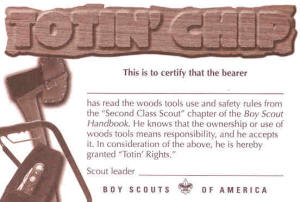
|
This card shows that the scout has read and understood the use and safety rules in the Scout Handbook and follows the responsibilities that comes with the card.
To earn this certification, a scout must show the Scoutmaster or any other designated individual that the following requirements have been met:
- Read and understand woods tools use and safety rules from the Scout Handbook.
- Demonstrate proper handling, care, and use of the pocketknife, axe, and saw.
- Use the knife, axe, and saw as tools, not playthings. Use them only when you are willing to give them your full attention.
- Respect all safety rules to protect others.
- Respect property. Cut living and dead trees only with permission and with good reason.
- Subscribe to the Outdoor Code and Leave No Trace.
The Totin' Chip card has four corners and these corners represent the number of infractions that a scout may have performed.
Any violation of these rules will result in a missing corner.
When all four corners are gone, the scout has lost his/her Totin' Chip rights.
|





